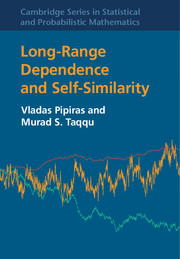Book contents
- Frontmatter
- Dedication
- Contents
- Expanded Contents
- List of Abbreviations
- Notation
- Preface
- 1 A Brief Overview of Time Series and Stochastic Processes
- 2 Basics of Long-Range Dependence and Self-Similarity
- 3 Physical Models for Long-Range Dependence and Self-Similarity
- 4 Hermite Processes
- 5 Non-Central and Central Limit Theorems
- 6 Fractional Calculus and Integration of Deterministic Functions with Respect to FBM
- 7 Stochastic Integration with Respect to Fractional Brownian Motion
- 8 Series Representations of Fractional Brownian Motion
- 9 Multidimensional Models
- 10 Maximum Likelihood Estimation Methods
- Appendix A Auxiliary Notions and Results
- Appendix B Integrals with Respect to Random Measures
- Appendix C Basics of Malliavin Calculus
- Appendix D Other Notes and Topics
- Bibliography
- Index
6 - Fractional Calculus and Integration of Deterministic Functions with Respect to FBM
Published online by Cambridge University Press: 11 May 2017
- Frontmatter
- Dedication
- Contents
- Expanded Contents
- List of Abbreviations
- Notation
- Preface
- 1 A Brief Overview of Time Series and Stochastic Processes
- 2 Basics of Long-Range Dependence and Self-Similarity
- 3 Physical Models for Long-Range Dependence and Self-Similarity
- 4 Hermite Processes
- 5 Non-Central and Central Limit Theorems
- 6 Fractional Calculus and Integration of Deterministic Functions with Respect to FBM
- 7 Stochastic Integration with Respect to Fractional Brownian Motion
- 8 Series Representations of Fractional Brownian Motion
- 9 Multidimensional Models
- 10 Maximum Likelihood Estimation Methods
- Appendix A Auxiliary Notions and Results
- Appendix B Integrals with Respect to Random Measures
- Appendix C Basics of Malliavin Calculus
- Appendix D Other Notes and Topics
- Bibliography
- Index
Summary
There are fundamental connections between self-similarity and fractional calculus, which is an area of real analysis. These connections are explored here in the context of fractional Brownian motion (FBM).
The basics of fractional calculus can be found in Section 6.1 where we introduce the following fractional integrals and derivatives:
• Riemann–Liouville fractional integral on an interval (Definition 6.1.1)
• Riemann–Liouville fractional derivative on an interval (Definition 6.1.4)
• Fractional integral on the real line (Definition 6.1.13)
• Liouville fractional derivative on the real line (Definition 6.1.14)
• Marchaud fractional derivative on the real line (Definition 6.1.18)
Representations of FBM are obtained in terms of fractional integrals and derivatives in Section 6.2. These representations then play a central role in developing deterministic integration with respect to FBM, and in being able to address various applications involving that process.
Integrals of deterministic functions with respect to FBM will be called fractional Wiener integrals. They are introduced in Section 6.3 and defined first as integrals on an interval (Section 6.3.2) and then as integrals on the real line (Section 6.3.6). Applications involving the Girsanov formula, prediction and filtering can be found in Section 6.4. Integrals of random functions with respect to FBM are introduced in Chapter 7.
Fractional Integrals and Derivatives
We provide here the basics of fractional integrals and derivatives on an interval (Sections 6.1.1 and 6.1.2) and fractional integrals and derivatives on the real line (Sections 6.1.3–6.1.5).
Fractional Integrals on an Interval
The standard way of motivating the definition of a fractional integral is to start with an n–tuple iterated integral and show that it can be expressed as a single integral involving the parameter n. The fractional integral of order α > 0 is then defined by replacing the integer n by the real number α in the resulting expression.
Let a < b be two real numbers and φ be an integrable function on [a, b]. A multiple integral of φ can be expressed as
- Type
- Chapter
- Information
- Long-Range Dependence and Self-Similarity , pp. 345 - 396Publisher: Cambridge University PressPrint publication year: 2017



